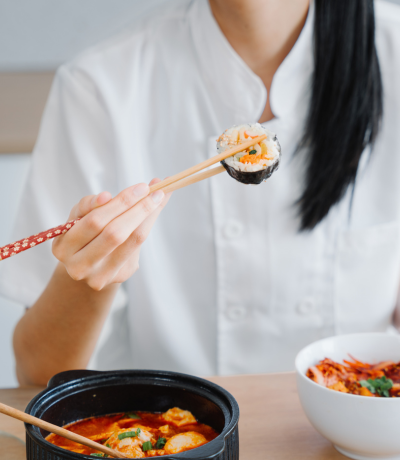How to Avoid Culinary Catastrophies
13 September 2024
Without a doubt, one of the best and most talked-about parts of any trip is the food, and that’s true anywhere you go in the world.
It’s not just about not having to cook or do dishes either. Whether slurping stew in a yurt after a chilly sleigh ride through a snowy forest in Finland or sipping aperitivos on a balcony over an impossibly blue lake in Italy, the meal makes the day.
That’s also why a bad meal lands badly in multiple ways. Not only did you waste your time, calories, and probably a good bit of money, but your travel day can feel like a waste when it doesn’t end in a good meal.
When traveling, you are also at the mercy of your research skills and recommendations—often with little or no time to recover if the restaurant lets you down, especially if you move quickly on to another location in your itinerary.
In the US, you can usually rely on carefully checking the restaurant’s website and online reviews, but restaurant websites aren’t as common in other countries.
Here’s how to avoid culinary catastrophes when you travel!

Learn and adhere to local dining times
If you want a good meal in a foreign country, you have to adhere to the local eating times. Do some research before your trip and learn what time people eat their meals, then adapt your schedule to follow suit.
If that means you need a 4 pm snack to get you to a later dinner time, then so be it! It will only take a day or two for your body to adjust.
Pro tip: Skip breakfast and opt for a snack between lunch and dinner!
Always be looking
The best tip to find that great restaurant that blows you out of the water is to Always Be Looking. As you tour the city and see the sites, keep an eye out for those special little places you can return to for lunch or dinner.
When you find a place you’d like to try later, drop a pin on Google Maps. Here’s how:
- Open Google Maps on your phone and find your current location.
- Press your finger on the restaurant location and hold until a little red pin appears.
- Once you’ve placed the pin, tap it to view the address and other information.
Pro tip: Be sure to wander away from tourist areas to find the most local meals.
Remember that not all locations in the world are as diligent about keeping the information online current, so when you get back to your hotel or sit down for coffee, do a little online research about the restaurant if you can
Scrutinize the menu
If the menu has a huge number of dishes or isn’t focused on a specific (preferably local) style of cuisine, that’s a sign of a generic restaurant. While it may not be terrible, it’s not likely to be the favorite meal of your trip, either.
Pro tip: Look for restaurants that feature chef’s specials. That’s a sign that the restaurant cooks meals that adhere to seasonally fresh foods.
Watch out for overly aggressive promotions
Restaurant touts are people hired to lure you in, and it’s often, but not always, a sign of desperation rather than quality.
Be cautious about aggressive promotions, including:
- Printed materials slipped in with your hotel key or under the door
- Discounts clearly targeted toward travelers
- Flyers pressed into your hands by salespersons
I’ve never enjoyed the meal at these restaurants when I’ve been tempted inside.
Pro tip: It’s OK to be suspicious of recommendations by the concierge. In some places, they may be paid to recommend particular places.
That printed thing, however, is an excellent conversation starter with someone local. Use it to get a good recommendation.
Approach Slowly
If you’re not certain about a place, approach with caution. Read the menu posted outside, and if there is none, ask the greeting staff if you can look at one.
There’s no reason you can’t start with a drink and an appetizer to assess the quality of the food and service.
- If the staff are attentive and knowledgeable, that’s a good sign.
- If there is a show or lots of theatrics, the food might not be the restaurant’s primary focus.
- If the starter is delicious, you’re probably good to continue.
- If the dishes that are being served around you look amazing, you’ve found the right place.
Pro tip: you don’t have to stay, even if you have a reservation. You can walk away and find somewhere else to conclude your meal.
Finally – dine where the locals go
This is the number one most important way to ensure that you are eating fresh food that is locally approved and reasonably priced.
That’s not to say that all restaurants frequented by tourists are bad; in fact, some are quite popular. If you want a locally sourced meal at a reasonable price, dine where the locals go.
How do you find out where the locals eat? That takes some finesse and observation. Try following these steps:
- Ask around. My best technique starts with a pre-dinner drink, or aperitivo, a friendly smile, and a light chat with the local bartender or staff. Politely ask for their advice. You may find it best to ask for dinner recommendations at lunchtime too!
- Follow a local. As you start looking for a restaurant, wander gently and become aware of who is local, then follow them (politely, of course).
Pro tip: Strike up a conversation with a local and ask for their favorite restaurant. Sometimes, they’ll even go with you!
Trust your instincts. You know a good meal when you see one, especially if it smells delicious when it’s walked by and placed sizzling hot on the table next to you.
Related topics
Damian Tysdal is the founder of CoverTrip, and is a licensed agent for travel insurance (MA 1883287). He believes travel insurance should be easier to understand, and started the first travel insurance blog in 2006.
